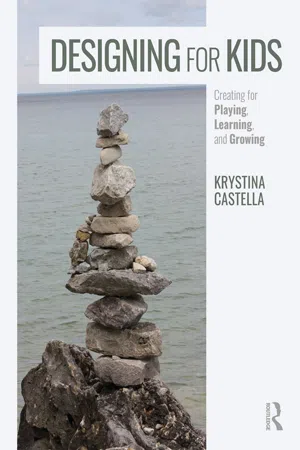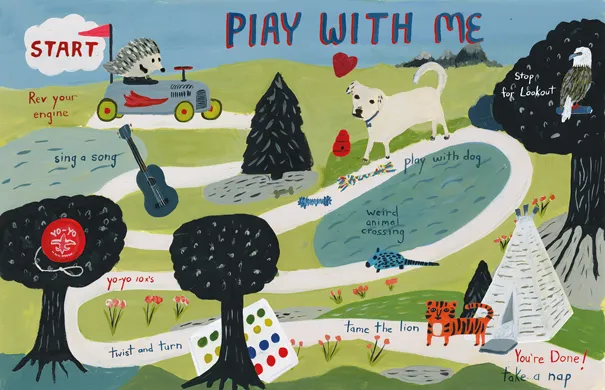![]()
![]()
Design is a journey. Designers tend to think of our process as linear, a step-by-step method starting with research, setting goals, making decisions, achieving milestones and culminating with the project release. Having a clear process that we can rely on is helpful, although designing is closer to jumping and skipping around following different paths based on insights, making unexpected connections and considering future aspects of the design process before it is time to dig into them more deeply. In fact, often the most innovative solutions come from stopping, reflecting, playing and breaking the linear path. An insight can bring us very close to the end more quickly than we had hoped or open up a world of solutions we never thought about at the outset of the project. Continuous back and forth between researching, considering, playing and designing encourages innovation throughout the whole adventure.
When designing for children and teens, we use the same processes that we use when we are creating for a general user. Art Director Scott Allen points out the similarities: “Designing for kids is like designing for any age: Tell your story. Know your audience. Discover an awesome design solution.”1 However, there are unique factors that make designing for children different, and we consider these factors in our research methods and project development.
What Makes Designing for Children Different from Aiming for a General User?
•Children and teens change quickly. Designers consider these changes and provide age-appropriate messages, materials, products, services and experiences. They are growing physically, cognitively, socially and emotionally.
•Children are dynamic, not static. Their brains and bodies are powered up for enrichment.
•Learning is attached to everything kids do. We continually question what the child will learn and build on for future learning. How will they be enriched?
•They are always experimenting and change interests frequently. We ask: how does our product, service, system or environment adapt to evolving interests?
•The user is often not the consumer. The designer considers multiple perspectives. Who will use it and who will buy it?
•Kids don’t have the same life or contextual experience as adults. We are always questioning how much they already know and what skills they will be bringing to the topic.
•In research and testing, it is hard to get from them exactly what they are thinking. Younger kids cannot yet verbalize their thoughts. Older kids just may not tell you. To uncover insights we use multiple approaches.
•Kids are erratic and chaotic. You never can predict how they are going to interact with or interpret your project.
•Kids are usually up for a challenge. They thrive on a sense of accomplishment from taking it on and succeeding or just trying.
•Kids love repetition. They can do things over and over again when most adults might get bored.
•Many things are new to them. There are a lot of first-time experiences throughout childhood.
•Safety standards are tight. An extra level of effort needs to be addressed to satisfy safety requirements.
•Kids are unforgiving users; they get frustrated easily, while adults are more forgiving. The design has to be frustration free.
•Kids love interaction and feedback. They often like being critiqued on what they are doing wrong and want to learn how to improve.
•Kids have a level of trust we outgrow as adults. We can use this to educate and protect them when we need to.
•Kids are a vulnerable population. We need to always question the ethics behind our interactions with them, for research, what we make, how we make it and how we market it to them.
•There is more freedom to create with fun/humor and play.
There are also many differences from child to child, in families, in culture and throughout the world. Designers try to understand those similarities and differences and use our creativity to nurture each child so they can thrive and achieve to their fullest potential.
Design Research
Defining the Problem
Sometimes we start projects with what seems to be a clear mission. For example, if we design applications for a software company, we begin with brainstorming new apps. If we plan exhibits for a children’s museum, we begin with developing ideas for new installations. It is smart to take a step back and ask, “What is the real problem that we are trying to solve?”
Kids know how to do it. As we get older, we lose that sense of questioning. Since questioning is a starting point for innovation, it is worth taking time to frame the problem to make sure we are working on the right issue. According to Warren Berger, author of A More Beautiful Question: The Power of Inquiry to Spark Breakthrough Ideas, “A beautiful question is an ambitious yet actionable question that can begin to shift the way we perceive or think about something – and that might catalyze to bring about change.”2 The right question sets up the framework for everything else that follows. For example, instead of starting with “What kind of toy should we make?” go broader with a question such as “What are potential solutions for play?” Strong questions do not know or imply the solution.
Goals and Objectives
Once we have our question, we outline measurable goals and objectives as the guiding force that drives the design process. Goals are the overall context and “what” of the project. What does this project hope to accomplish? Objectives are the “how” of the project. How will we accomplish the goal with specific tangible results? Sometimes these are solid from the beginning; others might change as priorities shift and we learn where we can create the most value and impact. Examples of goals and objectives may look like this for different types of projects:
Product Design
Goal: Provide illumination at night so a child can get out of bed safely to walk to the bathroom.
Objective: Create a lighting solution that allows a child to see when he awakes and not be scared.
Graphic Design
Goal: Communicate to children the social problems surrounding gun violence.
Objective: Create promotional pieces including books, videos and educational materials that inform children about gun ownership and its risks.
Environment
Goal: Offer inner-city kids opportunities for active play.
Objective: Create play environments and programs on unused city property.
Interactive
Goal: Teach kids phonetic awareness.
Objective: Create a system of products that prioritize sound to learn the alphabet to be used by 2–5-year-olds.
Project Brief
A brief gets everyone involved on the same page. Sometimes a project starts with a brief that is very clear in setting up the goals, objectives and outcomes expected. Other projects are freeform, and the objectives, goals and constraints are developed and shaped throughout the process. The origin of the brief also forms the approach to a project. A brief that starts in the design studio may be more design driven and include defining the user experience and the materials and processes. A brief written by education professionals might outline learning outcomes and assessment criteria. One written by the marketing department would be business focused, such as defining the customer, the price point and the positioning. A brief developed from the legal team could include legal criteria to meet, such as patentability or outlining the licensing strategy. Where there are multiple interests involved, it is best to work on the brief as a team and prioritize competing objectives.
A typical brief includes:
•Company profile or description of the client
•Title of project: Reflecting the purpose of the project in its title
•Project description: Goals, design objectives, marketing objectives, target audience, purpose, function and format
•Scope and technical requirements: Regulatory, safety and sustainability, with a detailed list of deliverables
•Project budget: Provides an idea of how much money is spent on different aspects of the project
•Project timeline and deadlines: List the project milestones. What needs to be complete and who is responsible? Review date/s and completion date
•Measures of success: How will you ensure the design is appropriate for your objectives and audience? How will you test the qualitative...

